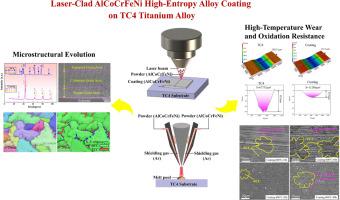激光熔覆TC4合金表面AlCoCrFeNi高熵合金涂层的显微组织特征及高温性能
IF 6.3
2区 材料科学
Q2 CHEMISTRY, PHYSICAL
引用次数: 0
摘要
本研究利用激光熔覆技术在Ti-6Al-4V合金基底上制备了AlCoCrFeNi高熵合金(HEA)涂层,并测试了其高温下的抗氧化性和耐磨性。涂层呈现出由平面、柱状和等轴晶粒组成的梯度显微结构,主要由BCC1 (alni2ti型)和BCC2 (fe - cr型)相组成,少量FCC相。等轴区具有纳米结构的共晶成分和元素偏析,硬度在650 ~ 740 HV0.5之间,明显优于TC4基体。在600℃时,涂层表现出显著的耐磨性,摩擦系数为0.32,磨损体积损失仅为TC4的六分之一。研究进一步阐明了涂层的氧化行为在600°C和800°C之间发生变化:尽管这两个温度都保持抛物线氧化动力学,形成致密的Cr2O3/Al2O3氧化层,但氧化物形成的顺序随着温度的变化而逆转,在600°C时Cr/Fe氧化物在共晶区开始形成,而在800°C时,受热力学和动力学竞争的驱动,Al/Cr氧化物优先在胞状晶粒上形成。这些发现强调了HEA涂层在高温环境下的卓越稳定性,为设计耐高温氧化涂层提供了重要的见解本文章由计算机程序翻译,如有差异,请以英文原文为准。

Microstructure characteristics and high-temperature properties of AlCoCrFeNi high entropy alloy coating on TC4 alloy prepared by laser cladding
This investigation utilized laser cladding to fabricate an AlCoCrFeNi high-entropy alloy (HEA) coating on Ti-6Al-4V alloy substrates, examining its oxidation and wear resistance at elevated temperatures. The coating exhibited a gradient microstructure comprising planar, columnar, and equiaxed grains, predominantly consisting of BCC1 (AlNi2Ti-type) and BCC2 (Fe-Cr-type) phases, with a minor fraction of FCC phases. The equiaxed regions featured a nanostructured eutectic composition and element segregation, with a hardness ranging from 650 to 740 HV0.5, significantly surpassing that of the TC4 substrate. At 600 °C, the coating demonstrated remarkable wear resistance, with a friction coefficient of 0.32 and wear volume loss amounting to only one-sixth that of TC4. The study further elucidated that the oxidation behavior of the coating varied between 600 °C and 800 °C: although both temperatures maintained a parabolic oxidation kinetics, forming a dense Cr2O3/Al2O3 oxide layer, the sequence of oxide formation reversed with temperature, with Cr/Fe oxides initiating at the eutectic regions at 600 °C, and Al/Cr oxides forming preferentially on the cellular grains at 800 °C, driven by thermodynamic and kinetic competition. These findings underscore the exceptional stability of HEA coatings in high-temperature environments, offering critical insights for designing coatings resilient to high-temperature oxidation
求助全文
通过发布文献求助,成功后即可免费获取论文全文。
去求助
来源期刊

Surfaces and Interfaces
Chemistry-General Chemistry
CiteScore
8.50
自引率
6.50%
发文量
753
审稿时长
35 days
期刊介绍:
The aim of the journal is to provide a respectful outlet for ''sound science'' papers in all research areas on surfaces and interfaces. We define sound science papers as papers that describe new and well-executed research, but that do not necessarily provide brand new insights or are merely a description of research results.
Surfaces and Interfaces publishes research papers in all fields of surface science which may not always find the right home on first submission to our Elsevier sister journals (Applied Surface, Surface and Coatings Technology, Thin Solid Films)
 求助内容:
求助内容: 应助结果提醒方式:
应助结果提醒方式:


